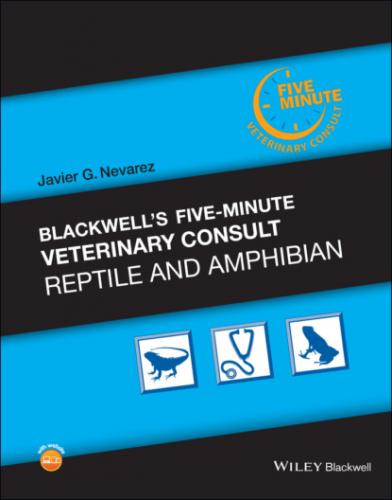Recheck feces on a routine basis
EXPECTED COURSE AND PROGNOSIS
Treatment should only be started if clinical disease is observed.
COMMENTS
N/A
ZOONOTIC POTENTIAL
Balantidium coli is the only known species to infect humans.
SYNONYMS
N/A
ABBREVIATIONS
SAF = sodium acetate acetic acid formalin
INTERNET RESOURCES
De Bosschere H, Roels S. Balantidium sp. and Nyctotherus sp.: Two common members of the digestive‐tract flora in Mediterranean tortoises. Tortoise Trust. https://www.tortoisetrust.org/articles/balantidium.htm
Divers SJ. Parasitic Diseases of Reptiles. MSD Manual Veterinary Manual, June 2020. http://www.merckvetmanual.com/exotic‐and‐laboratory‐animals/reptiles/parasitic‐diseases‐of‐reptiles
Suggested Reading
1 Hnizdo J, Pantchev N., eds. Protozoa (digestive tract). In: Medical Care of Turtles and Tortoises: Diagnosis, Surgery, Pathology, Parasitology. Frankfurt, Germany: Edition Chimaira; 2011:194–195
2 Jacobson ER. Parasites and parasitic diseases of reptiles. In: Jacobson ER, ed. Infectious Diseases and Pathology of Reptiles: Color Atlas and Text. Boca Raton, FL: CRC Press; 2007:571–666.
3 Rataj AV, Lindtner‐Knific R, Vlahovic K, et al. Parasites in pet reptiles. Acta Vet Scand 2011; 53(1):33.
Author Elsburgh O. Clarke III, DVM, DACZM
Buphthalmos
DEFINITION/OVERVIEW
Buphthalmos is an enlarged globe that is positioned normally in the socket.
ETIOLOGY/PATHOPHYSIOLOGY
An increase in IOP causing enlargement and distention of the globe secondary to chronic glaucoma.
SIGNALMENT/HISTORY
There is no standard signalment for this disease.
Common findings in the history may include tearing and squinting noted by the owners, as well as an asymmetry of the globes and loss of vision on the affected side(s).
CLINICAL PRESENTATION
While buphthalmos can be bilateral, most cases in chelonians are unilateral.
The corneal diameter of the affected eye is increased due to globe stretching.
There may be blepharospasm and epiphora.
Unlike exophthalmia, the conjunctiva and position of the nictitans is usually normal.
There may be red ciliary flush (red ring around the cornea) and congested episcleral vessels.
There may be lens luxation and/or cataracts in the affected eye(s).
Retropulsion of the globe is normal but the globe itself may feel firmer than normal.
RISK FACTORS
Husbandry
Diet and environmental factors are likely to have an effect on the development of cataracts.
Cataract development in brumating tortoises has been associated with damage from freezing temperatures.
Others
Trauma, especially if there is corneal penetration, can induce uveitis and cataract formation.
The presence of a cataract may increase the chance of lens luxation and/or lens induced uveitis, both of which can lead to glaucoma.
DIFFERENTIAL DIAGNOSIS
It is important to first differentiate between exophthalmia and buphthalmos.
Glaucoma in chelonians is usually secondary to outflow obstruction of the aqueous humor, which is most often caused by uveitis, lens luxation, or intraocular neoplasia.
DIAGNOSTICS
Physical examination findings should raise suspicion of buphthalmos, which is confirmed by finding elevated IOP.
Normal IOP in three tortoise species has been reported to be 15.74 ± 0.2 mm Hg (Testudo hermanni), 14.2 ± 1.2 mm Hg (Geochelone denticulata), and 15.3 ± 8.81 mm Hg (Geochelone carbonaria) and in six turtle species at 5.42 ± 0.96 mm Hg (Emys orbicularis), 6.7 ± 1.4 mm Hg (Terrapene sp.), 8.3 ± 1.5 mm Hg (Terrapene sp.), 5.42 ± 1.7 mm Hg (Trachemys scripta elegans), 10.02 ± 0.66 mm Hg (Trachemys scripta elegans), 6.5 ± 1.0 mm Hg (Lepidochelys kempii), 3.8 ± 1.1 mm Hg (Lepidochelys kempii), and 4–9 mm Hg (Caretta caretta).
Since most cases are unilateral, a significant difference in IOP between the eyes may be most indicative of a problem.
Ocular examination and ultrasound are helpful in further evaluating the root cause, although the scleral ossicles can limit visualization.
PATHOLOGICAL FINDINGS
Chronically elevated IOP will lead to pain and blindness.
APPROPRIATE HEALTH CARE
N/A
NUTRITIONAL SUPPORT
Additional nutritional support is not necessary in most cases if the IOP can be brought down.
If needed, tube feeding can be used to provide nutritional support.
CLIENT EDUCATION/HUSBANDRY RECOMMENDATIONS
While buphthalmos can occur in any animal, those with husbandry deficiencies may be at increased risk.
In addition to medical and surgical therapy, maximizing the husbandry of the animal will improve the chance for a successful
